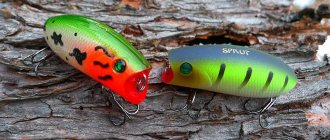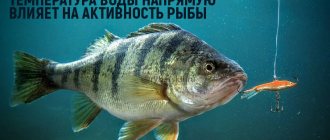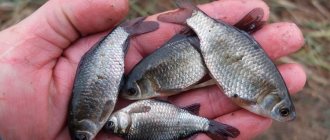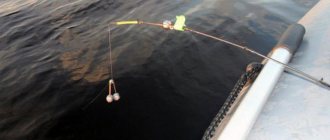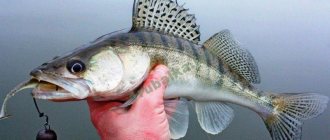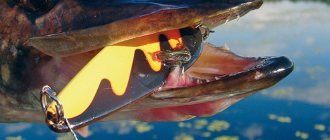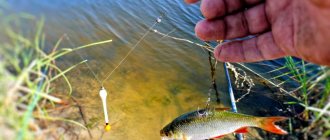It's no secret that fish don't bite 24 hours a day, especially when it comes to catching a predator. Now I won’t reveal a secret to anyone by saying that the best fishing time is at dawn and sunset, as well as during the periods adjacent to them. It's obvious! Now think about how often you fished during these particular time periods? Most likely not often. This is usually what happens; to catch the sunrise you have to get up too early, and then the fishing will go awry due to the short sleep at night.
A similar situation arises with evening fishing. Solutions to a problem are possible if you consider it a problem. First of all, we need to figure out whether such sacrifices will be justified. If there is information about the morning/evening exits of a predator or the accumulated experience suggests that it is necessary to catch at that particular time, then we need to act. For short fishing trips, the key points are:
- it’s better to concentrate your attention in a narrow direction and there is no need to be scattered over trifles, this applies to time, place of fishing and equipment. That is, either go to the “dawn” or to the “evening”. In fact, such fishing trips will be less time-consuming, unlike regular trips;
— it’s better to fish on bodies of water that are nearby and have good access to the water;
— you need to take a minimum of gear and bait. Everything must be prepared in advance;
— choosing the “right” place is key for such fishing.
Choosing a fishing spot
It is a choice, not a search or anything like that.
You need to walk or swim to an area where fish should be present, at least that’s what it should seem like to the fisherman. Otherwise, the whole point of such fishing is lost. When fishing from the shore in the morning and evening hours, you should give preference to places where the following are present: - frequent changes in depth;
— sandy or rocky spits located near depth;
- exits and entrances from pits and pools;
— flooded structures (roads, bridges, remains of construction waste);
- accumulation of fry.
In the summer, in such places the predator will show itself in bursts. If you notice frequent splashes of fish in an unknown area, it is worth exploring and checking this place. In autumn, the predator gravitates more to deep places and changes summer sites.
When fishing from a boat, the spots remain the same, but the angler expands his range of possibilities. Happens often
so that when fishing from the shore you have to make very long casts or, in general, it is not possible to reach the place of the active predator, but when using a boat the problem disappears.
Places to catch predatory fish in summer
Promising places for catching large predatory fish in summer are areas with weak currents and relatively shallow depths.
Usually, in summer they catch pike, perch, and pike perch here with the help of summer baits that come to feed on small fish.
Stations and circles on the river are placed in areas with weak currents - in bays, backwaters not far from the riverbed.
It is better to choose a place for catching large predatory fish in a closed reservoir in summer near the depth difference on the shallow side.
Smaller pike and squint can feed in the summer on medium-sized baitfish in shallow waters overgrown with algae.
Live bait is usually caught near the installation site of summer girders, and loaded tackle is placed near the shelters of predatory fish: snags, bridge piles, and in old river beds - along the edge of seaweed.
On rivers with strong currents and many riffles, the best places for catching large predatory fish in summer are considered to be areas with deep reaches, replete with bottom heterogeneities in the form of boulders, sunken trees, tables, shallow longitudinal and transverse grooves.
Due to the depth below the riffle, the river flow weakens, so in such places fishing can be successful throughout the entire summer period, both for predatory fish and for representatives of peaceful cold-blooded species.
Where, after rapid rapids, nature has formed deep pools, predatory fish in the rivers are caught at the end of summer with spinning lures. In the fall, snag holes can be promising for catching pike perch, pike perch, and perch from a boat using vertical lures.
Spinning fishing tactics
The key to good spinning fishing is not only time and place. Often, the final result is greatly influenced by the approach itself. Many anglers make the same mistake, arriving at the appointed time and place before the predator arrives. And they wait for him, remaining in place. I would like to note that if the predator does not show activity, you should not annoyingly throw the bait in the same place. Any manipulation of the bait in the water does not go without a trace. As a rule, this greatly alarms fish, especially inactive ones.
A predator that has not yet begun to feed arrives in this alert state. Therefore, if during the first few casts there are no bites, then it is better to leave this place for a while and return to it later.
Mobility is the key to success in catching predators with a spinning rod
Considering that the main fishing time fits into a very narrow time frame, it is necessary to use it skillfully.
Fast movement, combined with the rational use of correctly selected baits and changing them, can give much more effect than waiting in place. Mobility is not just about how fast an angler moves. If you count the time spent fishing, it turns out that a lot of time is spent on manipulating gear: changing bait, equipment, equipping the bait. As a rule, the basis of the problem lies in a low level of training, which can be corrected while still at home, or in the wrong tactics. Everyone decides for themselves how to collect gear; I use a simple rule: the less, the better. This applies to any bait. You need to have two or three main baits of different directions and a reasonable replacement in case of loss of one of them. Mobility is also affected by re-equipment during the fishing process. That is, when you have to replace the jig with a wobbler or a lead rig. In such cases, fishing methods that require more subtleties in the equipment process will be losing, and these are all lead rigs, drop shot and Texas in the classic version. These fishing methods can also be canceled because it is hard to call them high-speed or search methods. When choosing baits, you need to focus on those that can be quickly changed, are easy to control and catch, and these are jigs, wobblers of different directions, rotating and oscillating spoons.
Catching big fish in summer
Under the steep banks of rivers there are often deep holes - favorite places for large fish to stay in the summer throughout the open water season. A hole in the river is shown in the background of the photo.
By choosing a fishing spot on a river under a steep bank, a fisherman can become the owner of large bream, carp, chub, burbot, perch, or even catfish during summer or autumn fishing.
Also excellent places for summer fishing on rivers are channel holes, especially their entrance and side dumps. And it will be better if the hole is located immediately behind a shallow riffle.
The best fishing spots in summer are considered to be areas with closely spaced irregularities in the river bed, where a steep bank with a channel hole turns into a flat bank with a cape protruding far away.
A good place for summer fishing may be the side dump of a pit, into which a stream of current flows from a river rift. This place will be even better for fishing if horizontal platforms have formed on the top of the pit - ledges, or even long terraces.
It is on the tables of the side dump of the pit that most of the feed is retained. At the lower level of the pit itself, a lot of summer food also settles, which is immediately eaten by fish, whose appetite in the summer largely depends on weather conditions.
When choosing a place for fishing in a river hole, especially from a boat on side donks or other gear, it is better in the hot summer to anchor on a dump in a hole from the side of the incoming river current.
You can’t go wrong in choosing a place to fish, and if you feel from a boat in a large hole in the river, there is a table - an area raised above the flat bottom, where a lot of fish food also lingers.
Fishing option in the light spinning class
I like this class of fishing because it can be easily changed - using the same tackle, you can fish with completely different baits, without losing much in quality. The only limitations are the size and weight of the baits. As a rule, fishing spots are located at different distances from the shore, using different baits, you can focus on a specific area. I often fish according to this principle - I fish the farthest possible zone, for this I use a jig with a compact bait that has an active game.
Among the recent new products, I really liked the Awaruna ejector tails from Pontoon21. Thanks to its elongated body, the bait does not float too much when casting, and it can be delivered over considerable distances. And also in the bait, ideas are implemented that have no analogues, namely a channel-hole inside the bait, which allows you to equip the bait with a double with maximum convenience. The bait is also edible.
If fish activity is observed closer to the shore, you can switch to a smaller jig load; for this, there must be an assembled bait in the box. Lately, when light fishing I have been using the following gear: spinning rod St.Croix Legend Tournament 70 LXF2 3.5-9 g, Shimano reel
Twin Power 2500 FA, 0.8 cord according to the Japanese classification, I often use the 4-core Pontoon21 Exteama 12 lb (0.8) cord.
This tackle is the most suitable for me, according to my fishing concepts, it is convenient, versatile, sensitive and has a margin of safety. I collect jig baits with weights of 6, 10 and 14 g with rubber of different sizes. When there is activity relatively close to the shore, it makes sense to alternate baits. For example, start fishing with a jig, then, if necessary, reduce the weight of the load, and then switch to fishing with a wobbler suitable for the conditions.
Catching a predator in snags
Walleyes feel right at home there
. Migratory pike perch is also very fond of snags, where it rolls down after spawning. In the fall, with the onset of frost, the autumn migration of pike perch to their wintering grounds begins. Migrating pike perch stop to rest in deep holes. At this time, catching a predator in snags is the most interesting fishing.
Very large, well-fed pike perch and trophy-sized pike are caught in snags .
The task of catching a trophy specimen becomes feasible.
The fact that pike perch feels confident in snags is related to its behavior. All other things being equal, pike perch will always bite more confidently in snags than in other places, and will always be less demanding on the quality of the wiring. Even in proven places where pike perch regularly raid in order to profit, the bite may be weak or not at all. And in the snag there is always a chance to earn several, albeit weak, but very real bites.
To catch fish where others do not always dare to throw bait, to carry out delicate wiring almost centimeters from the dead hook.
Catching a predator in snags is a fascinating activity; jumping the bait from branch to branch of the underwater forest, feeling a powerful pike perch bite and managing to pull the robber out from under the snags is worth a lot.
What does it mean to catch several normal specimens, lure them out, tease the pike perch on the most “not cool” day. We go to the river not for meat, but for sensations.
The determining factors for successful fishing in snags are not motors, boats, echo sounders and “cool” gear. Completely different things contribute to success, such as experience and patience.
Long casting - for a cautious predator
There are many benefits to long-range fishing. Firstly, a little-fished area becomes available. Secondly, at long distances the fish is less careful and responds to the bait immediately. The most common targets for fishing are asp and pike perch. Based on this, the choice of bait will be appropriate.
When fishing for walleye, the number one bait is the jig. When catching asp, different options are possible. Kastmaster allows you to fish at extreme distances in different layers of water. In order to deliver the bait to the desired distance, you will need appropriate gear, this is especially true when choosing a spinning rod. Here the emphasis is on range, power characteristics and sensitivity. Traditionally, “Americans” are popular in this fishing - the Certified Pro series from Lamiglas has been and remains extremely popular among fans of fishing from the shore with pike perch jigs and asp spinners. And recently a very interesting Pontoon21 spinning rod appeared on Lamiki forms. The new products are all up to par - powerful, long-range and sensitive American blanks combined with excellent assembly, high-quality fittings and ergonomics. The presented model range is wide, so there is plenty to choose from. For long-range fishing, the best model is the Detonada DTS102 MHXF 14–46 g - a powerful, sensitive spinning rod that allows you to make long and accurate casts.
In cases where the asp does not reveal itself on the surface, it is more appropriate to fish in the water column or near the bottom. In addition to oscillating spoons, I use a jig bait with a vibrating tail. The most difficult thing when fishing like this is to determine the desired fishing horizon. When this is done, all that remains is to methodically fish the asp site.
Predator fishing gear
Fishing gear such as spinning rods are considered sports, since fishing with them is quite difficult. Spinning rods are used exclusively as gear for catching predators using moving bait. Autumn fishing does not impose any special requirements on equipment; you can use a spinning rod and reel that you use in the summer. Although, it may be better to use a more powerful rod, taking into account the fact that you will still have to fish in “deep” places. You can use 0.16-0.19 mm braid. Such a fishing line, taking into account the loss of strength at the knots, holds more than 10 kilograms, and this is enough to save the bait when hooked in most cases, as well as cope with almost any fish. The use of leashes when fishing for predators is almost always necessary. The only exception is fishing for pike perch. But here it is necessary to remember that in summer pike and pike perch separate reservoirs more clearly than in autumn. In summer, pike perch stays on the edges and near the bottom, close to the shore, approaching only at dusk, and pike spends a significant part of its time near the grass thickets, close to the shore. Of course, their paths intersect, but the division of hunting areas is visible quite clearly.
Catching a predator with a spinning rod
But in the autumn, when the pike goes into the depths, it is difficult to be sure, intending to catch pike perch, that there will be no pike in this place.
Therefore, it would be good to always have leashes. A pike weighing up to one kg immediately bites through any braided fishing line up to 0.4 mm in diameter, sometimes it is not possible to notice the moment. A small “push” - and the bait was no longer there.
Of course, any leash invariably worsens the performance of the bait, and also reduces the number of bites, although, in my opinion, it is more important to get one bite and at the same time pull out a pike than to notice four bites and not catch any. Pike leashes are not very alarming even when fishing in clear water with “oscillators”. The pike swims after the spoon and rushes at it, despite the strong leash.
Another thing is catching a predator with live bait in clear water. Here the presence of a leash has a very noticeable effect: the fry begins to move unnaturally, and in addition, the predator will have time to examine the leash. Which leashes are better, any angler decides for himself. I am satisfied with tungsten ones with a tensile load of 4 - 5 kg. There is no need for more on reservoirs.
Tungsten leashes are sold in a wide variety of options - simply with loops and equipped with carabiners and swivels. It is, of course, more convenient to have them already equipped, although they do not have high-quality fasteners. As a result, many people prefer to purchase leashes with loops. You should also take into account that you cannot combine a metal leash with a fishing line directly. Fibers, even if they are tungsten, fray the fishing line extremely quickly. Such a connection begins to lose strength after three to four casts. So the combination of the fishing line and the metal leash through the winding ring or swivel is mandatory.
Surface fishing with spinning rod
Surface lures add a pleasant touch to everyday fishing.
Most often, surface activity is observed in the warm season in periods bordering on darkness, in the morning and evening. It is not necessary that a predator should give itself away in bursts. Being in the water column, active fish are able to rise several meters. I have repeatedly observed such a picture on overgrown reservoirs in the morning, when there were much fewer bites on the classic bait for this place than on the surface bait. In such a situation, the Megabass Dog-X SL helped me a lot, which did an excellent job with its goal, thanks to its sweeping play and the sounds it made, it attracted pike from great distances.
Surface fishing is distinguished by its distinctness: either yes or no. If fishing with surface baits is justified under these conditions, then the result will not be long in coming. Depending on the conditions, you can use a variety of gear, so I will not consider the arsenal of gear in this section.
Searching for a promising area for catching predators
Every angler knows that it is good to find places with sharp turns so that the channel is closer to its shore. The more trees and bushes on the shore, the richer the food supply will be. You can count on catching asp, chub, ide, pike and perch. In overgrown areas with shallow depths in summer and autumn, you can count on catching grass pike and good perch.
Experienced fishermen can easily read new bodies of water. But even they use maps and echo sounders. In any case, it is necessary to find such an area that both fish can be found in it and access to the fishing grounds is acceptable.
It is very important to know how the fish in a given body of water are used to feeding. You should take into account its habitat and know its feeding hours. The speed of the current is of great importance. On regulated rivers, when the strength of the current increases, active fish biting is often observed. It is necessary to keep an eye on such moments in order to have a good chance of catching trophies.
Particular attention should be paid to areas where tributaries flow into large rivers and reservoirs.
The length of the selected section should be 1-2 km. It should contain places with depths of 3-5 meters and 8-10 m if we are targeting pike perch. It is very good if in such a meta there are oxbow lakes, along the tributaries of which cattails will grow.
Pike are often concentrated in spills. Pike perch also likes to visit such places.
